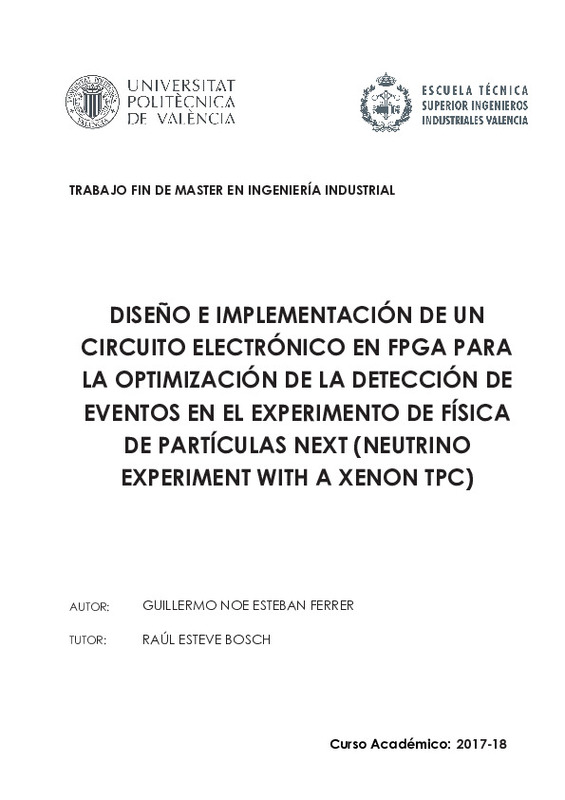JavaScript is disabled for your browser. Some features of this site may not work without it.
Buscar en RiuNet
Listar
Mi cuenta
Estadísticas
Ayuda RiuNet
Admin. UPV
Diseño e implementación de un circuito electrónico en FPGA para la optimización de la detección de eventos en el experimento de física de partículas NEXT (Neutrino Experiment with a Xenon TPC)
Mostrar el registro sencillo del ítem
Ficheros en el ítem
| dc.contributor.advisor | Esteve Bosch, Raul
|
es_ES |
| dc.contributor.author | Esteban Ferrer, Guillermo
|
es_ES |
| dc.date.accessioned | 2018-10-11T15:21:27Z | |
| dc.date.available | 2018-10-11T15:21:27Z | |
| dc.date.created | 2018-09-27 | |
| dc.date.issued | 2018-10-11 | es_ES |
| dc.identifier.uri | http://hdl.handle.net/10251/110279 | |
| dc.description.abstract | [ES] El experimento NEXT pretende, mediante el estudio de la desintegración doble beta del xenón en una cámara TPC, demostrar que el neutrino es su propia antipartícula. Para ello, se debe estimar la energía de las desintegraciones doble beta que ocurren en la cámara, pero teniendo en cuenta que ocurren otros eventos en la cámara al mismo tiempo, siendo necesario discriminarlos. El sistema de trigger es el encargado de discriminar qué eventos poseen una energía de interés, por lo que la eficiencia de este sistema afecta a la capacidad del sistema para adquirir datos. Este trabajo plantea la implementación de un shaper digital que permita mejorar la discriminación de eventos en el sistema de trigger, mejorando así su eficacia. Para implementar el shaper se desarrollará un modelo informático del trigger que permitirá discriminar, entre los eventos previamente adquiridos, eventos no válidos. Mediante este modelo se podrán cuantificar los efectos del shaping obteniendo los parámetros que maximicen la proporción entre eventos válidos y no válidos. Con estos parámetros definidos se realizará la implementación del shaper en el sistema de trigger del experimento para, finalmente, evaluar la eficacia y viabilidad del shaper mediante el análisis de datos reales del detector NEXT-NEW actualmente instalado en las instalaciones del Laboratorio Subterráneo de Canfranc (LSC). | es_ES |
| dc.description.abstract | [EN] The NEXT experiment pretends, through studying the double beta decay of xenon on a TCP camera, to demonstrate that the neutrino is its own antiparticle. To do this, is necessary to measure the energy of the double beta decays occurring in the chamber. However, there are a large number of other events occurring in the chamber, so is necessary to discriminate the events occurring in the chamber. The trigger system is the responsible for discriminating which events have an energy of interest, therefore, the efficiency of this system affects the capacity of the system to acquire data. This work proposes the implementation of a digital shaper in the trigger system. The shaper will allow a greater discrimination of events, improving the effectiveness of the trigger. To implement the shaper a computer model of the trigger will be developed, this model will process the data acquired by the experiment and will be able to discriminate invalid events in order to quantify the effects of the shaper, this will allow to obtain the parameters of the shaper that maximize the ratio between valid and invalid events. With these parameters defined the shaper will be implemented in the trigger system of the experiment, to finally evaluate the efficacy and viability of the shaper analysing the real data collected from the NEXT-NEW detector located under the mountains in Canfranc. | es_ES |
| dc.language | Español | es_ES |
| dc.publisher | Universitat Politècnica de València | es_ES |
| dc.rights | Reconocimiento (by) | es_ES |
| dc.subject | NEXT | es_ES |
| dc.subject | shaper | es_ES |
| dc.subject | Python | es_ES |
| dc.subject | FPGA | es_ES |
| dc.subject | trigger | es_ES |
| dc.subject | digital. | es_ES |
| dc.subject.classification | TECNOLOGIA ELECTRONICA | es_ES |
| dc.subject.other | Máster Universitario en Ingeniería Industrial-Màster Universitari en Enginyeria Industrial | es_ES |
| dc.title | Diseño e implementación de un circuito electrónico en FPGA para la optimización de la detección de eventos en el experimento de física de partículas NEXT (Neutrino Experiment with a Xenon TPC) | es_ES |
| dc.type | Tesis de máster | es_ES |
| dc.rights.accessRights | Abierto | es_ES |
| dc.contributor.affiliation | Universitat Politècnica de València. Departamento de Ingeniería Electrónica - Departament d'Enginyeria Electrònica | es_ES |
| dc.contributor.affiliation | Universitat Politècnica de València. Escuela Técnica Superior de Ingenieros Industriales - Escola Tècnica Superior d'Enginyers Industrials | es_ES |
| dc.description.bibliographicCitation | Esteban Ferrer, G. (2018). Diseño e implementación de un circuito electrónico en FPGA para la optimización de la detección de eventos en el experimento de física de partículas NEXT (Neutrino Experiment with a Xenon TPC). http://hdl.handle.net/10251/110279 | es_ES |
| dc.description.accrualMethod | TFGM | es_ES |
| dc.relation.pasarela | TFGM\1507 | es_ES |
Este ítem aparece en la(s) siguiente(s) colección(ones)
-
ETSII - Trabajos académicos [10404]
Escuela Técnica Superior de Ingenieros Industriales






